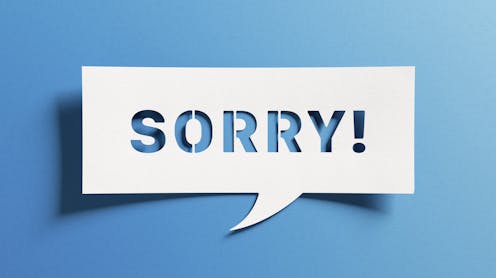More than just ‘we’re sorry’ – how companies can make apologies we will actually believe
- Written by The Conversation

When a company makes a mistake – such as a marketing misstep or a product failure that leads to a recall – a good apology can make a big difference in how we as customers feel about them.
Things can go wrong for all kinds of reasons. On top of addressing the immediate fallout of something going wrong, a company must be prepared to explain what happened – and in many cases, apologise.
A well-intended, expertly delivered apology can help rebuild trust, while a bad one can often make things worse.
Our research has explored the different kinds of apologies that companies typically offer, and what key factors make a good one.
Understanding these nuances can help firms handle crises better and maintain positive relationships with their customers. It can also help us – as customers –make our own judgements about how genuine corporate apologies are.
How companies say ‘we’re sorry’
Not all apologies have the same intention and effect. Across the long history of corporate apologies, four key types emerge.
Incomplete apology
An incomplete apology is one that fails to fully accept responsibility, or leaves out important details like how the problem will be fixed.
In 2017, Dove launched an ad campaign that was widely panned as racist. After extensive backlash, the company issued an apology, saying it deeply regretted “the offence it caused”.
But Dove was then further criticised on social media for failing to fully admit fault or explain how the company would prevent such a mistake in the future. Such an approach risks leaving customers feeling unsatisfied and distrustful.
Doublespeak apology
A doublespeak apology uses confusing language and excuses to avoid admitting fault.
In 2018, Chinese travellers were required to pay more than those of other nations as part of a promotion to get a discount voucher from World Duty Free at Heathrow Airport.
Soon after, World Duty Free issued an apology in both English and Mandarin, saying it had “taken urgent steps” and “comprehensively re-briefed staff” to ensure the promotion was clear.
While World Duty Free’s apology in Chinese explicitly addressed “the Chinese public”, its English version did not.
This discrepancy caused many media outlets in China to express frustration.
China Daily tweeted:
There is no sincerity in the statement as it neither explains the reason Chinese customers had to spend more nor gives a solution to prevent that from happening again.
Doublespeak apologies can create the perception a firm is trying to dodge responsibility, which customers are likely to perceive as dishonest.
Full apology
A full apology includes all the necessary parts: admitting to a mistake, accepting responsibility, expressing remorse and committing to promptly address the issue. This kind of apology helps rebuild trust.
In 1982, Johnson & Johnson faced a crisis after some Tylenol capsules were found to be laced with poison, leading to a number of deaths.
But the company quickly admitted there was a problem and took responsibility for fixing it with mass warnings and recalls. The crisis ultimately led to the development of tamper-proof packaging for medications.
Such a thorough response helped the brand restore its reputation over time.
Extended apology
An extended apology goes even further by including long-term commitments to change and corrective action, such as compensation. This is the style we most like to see, and shows a company is serious about making things right.
In 2018, Starbucks closed many of its stores to provide staff with racial bias training after an incident of discrimination.
Starbucks’ chief executive at the time, Kevin Johnson, recorded a personal apology message.The company’s extended apology showed a commitment to broader change and helped rebuild customer trust.
What makes for a good apology?
If a company doesn’t fully acknowledge the harm caused when something goes wrong, its customers will feel ignored. Vague promises to fix an issue that lack meaningful details can also undermine trust.
Three key factors can make or break a corporate apology.
Spokesperson
Who delivers an apology matters a lot. The authority of a top official, such as the chief executive, makes the apology more believable.
In 2018, after it emerged Facebook had been used for widespread data harvesting, chief executive Mark Zuckerberg apologised himself, intending to convey the company was serious about fixing the problem.
Facebook founder Mark Zuckerberg apologised following major privacy concerns in 2018.In contrast, choosing a spokesperson who lacks authority or credibility can weaken an apology.
Delivery
How an apology is delivered is important, too. It should be communicated broadly through rich media channels that are specifically able to reach the affected audience, such as social media, television or a company’s website.
Facebook’s 2018 apology was delivered not only on the site itself, but also before congressional committees, in television interviews and across full-page newspaper ads.
Timing
Finally, the timing of an apology is crucial. Apologising quickly shows the company is serious about fixing the issue. Delayed apologies can frustrate customers and signal a lack of urgency or that an issue isn’t a priority.
Showing genuine care
In the end, a corporate apology should be about more than just saying “we are sorry”. It requires a thoughtful approach that considers what is said and when, who says it and how it’s delivered.
Companies need to be sincere, transparent and quick. This goes to the very heart of what’s required to rebuild trust – acknowledging their customers and showing that they genuinely care.














